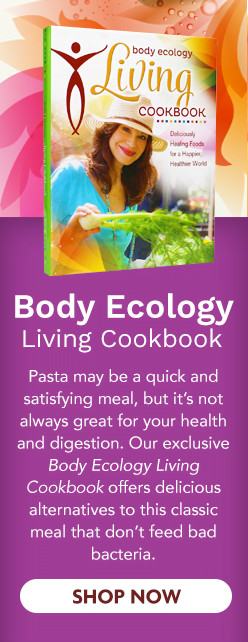What Eating Pasta Does To Your Body (And What To Eat Instead)

The low-carb craze demonized our love affair with pasta. Many of us are now convinced pasta is a “bad” food, and when the goal is to create a healthy inner ecosystem and build immunity, most popular pasta dishes really are a poor choice. But, while some pastas are best avoided, some can actually be healthy.
Keep reading to find out which pastas to avoid and which ones may be good for you.
The Problem With Pasta
If you’re wondering what pasta is made of, it mostly contains durum wheat flour, a special kind of wheat with a high protein content and strong gluten. Pasta may seem fairly nutritious, but it’s still a refined and processed food.
Italian studies have even linked an increased risk of cancer to pasta and rice consumption.¹ And unbelievably, multiple studies on pasta’s purported benefits over the past decade have been funded by the world’s largest pasta manufacturer, Barilla.²
From the Body Ecology perspective, conventional pastas feed pathogenic yeast and bacteria in your intestines. They disturb the growth of good microbes and may lower your immunity. Candida, a systemic fungal infection, especially thrives on the natural complex sugars in pasta that can ferment in your gut and encourage candida overgrowth.
If you want to build your inner ecosystem with beneficial microbes, then most pastas are not for you.

Your body and your tastebuds will thank you: The Body Ecology Living Cookbook has 250+ gut-smart recipes.
Pass The Healthy Pasta, Please: 4 Tasty Options!
Pasta is a filling, cheap, and easy meal that also tastes great. But it’s not always the most nutritious way to fuel your body. So, what’s a pasta lover to do?
Fortunately, new choices for healthy pasta make it easy to enjoy the occasional plate of noodles without worrying about harming your digestive health.
Several new varieties of pasta are actually good for you:
1. Konjaku Noodles
- Healthy pasta is not too good to be true! Konjaku (or shirataki) noodles are delicious, filling, and gluten-, calorie-, and carb-free.
- These healthy pasta noodles are made from the yam flour of the Japanese konnyaku imo tuber. This special flour is a powerful prebiotic because it’s full of fiber that does not feed bad bacteria.
- If you want pasta more often, then Konjaku noodles are our top recommended alternative.
- Topped with vegetables and a yummy carrot and ginger Body Ecology sauce, they make a complete, satisfying, and quick meal. You won’t even miss your old pasta with cream sauce!
2. Zucchini Noodles, Or “Zoodles.”
- With how popular zucchini, butternut squash, and other veggie noodles have become, you probably know how to spiralize your own
 at home by now. You can also buy veggie noodles premade at most grocers.
at home by now. You can also buy veggie noodles premade at most grocers. - If you’re buying prepackaged, make sure to blanch your veggie noodles in boiling water as bacteria can build on them. This bacteria buildup may cause a histamine reaction for those who are sensitive. (Note that L. plantarum found in Body Ecology Veggie Culture Starter is great for helping to degrade histamine.)
- Top your zoodles with some extra virgin olive oil, fresh basil, and a dash of Celtic sea salt, and you have a delicious, quick meal that complements a spring mix salad and your favorite ocean vegetable.
3. Spaghetti Squash Noodles
- The texture of spaghetti squash is naturally similar to pasta noodles.
- The squash is gluten-free, low-carb, and high in fiber and nutrients.
- To cook spaghetti squash, halve a squash, scrape out the seeds, and cook it with 1 ½ cups of water on high for 15 minutes in an Instant Pot.
- Use a fork to scrape out cooked and cooled spaghetti squash strands.
On top of being alkaline forming — since we need 80-percent alkaline-forming foods combined with 20-percent animal protein — nourishing, veggie-based pasta alternatives add important fiber to your diet. This supplies essential fuel for the friendly bacteria in your gut that use this fiber to make the short-chain fatty acid butyrate.
4. Alternative Flour Pastas
- Store bought lentil pasta can be used in place of your favorite type of pasta. However, lentil noodles are high in oxalates.
- Jovial makes a grain-free cassava spaghetti that is low in oxalates. We prefer this to lentil pasta if you’re following a low oxalate diet.
- Jovial also makes the best-tasting organic brown rice gluten-free pasta out there. It’s artisan-crafted in Italy and has been given an award for the best taste and texture for a rice pasta.
These flour-based pastas aren’t really in the healing food category, so should not be eaten often, but certainly are your better choices when you have that craving for pasta. Serve them with cultured veggies on your plate to enhance digestion.
After some time on the Body Ecology System for Health and Healing, you might find that your body will no longer want the wheat pastas of your past.

At Body Ecology, we’re always looking for delicious alternatives to unhealthy favorites. After all, we deserve to love what we eat, and yet, we want to eat what makes us feel good for the long-term. See how your body feels as you ditch your old pasta and try konjanku or zoodles instead.
Your body and your tastebuds will thank you: The Body Ecology Living Cookbook has 250+ gut-smart recipes.
- 1. Dalmartello M, Bravi F, Serraino D, et al. Dietary Patterns in Italy and the Risk of Renal Cell Carcinoma. Nutrients. 2020;12(1):134. Published 2020 Jan 2. doi:10.3390/nu12010134.
- 2. Victor L Fulgoni, III, Regan Bailey, Association of Pasta Consumption with Diet Quality and Nutrients of Public Health Concern in Adults: National Health and Nutrition Examination Survey 2009–2012, Current Developments in Nutrition, Volume 1, Issue 10, October 2017, e001271, https://doi.org/10.3945/cdn.117.001271.









